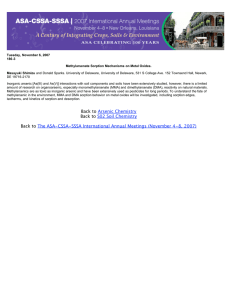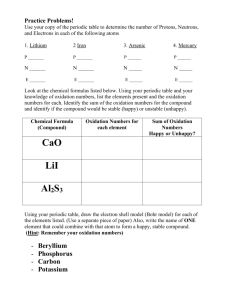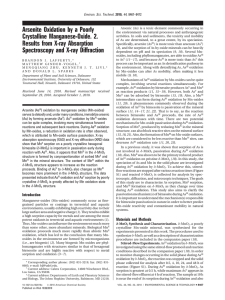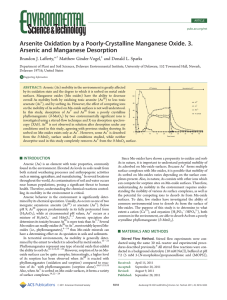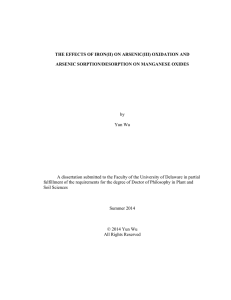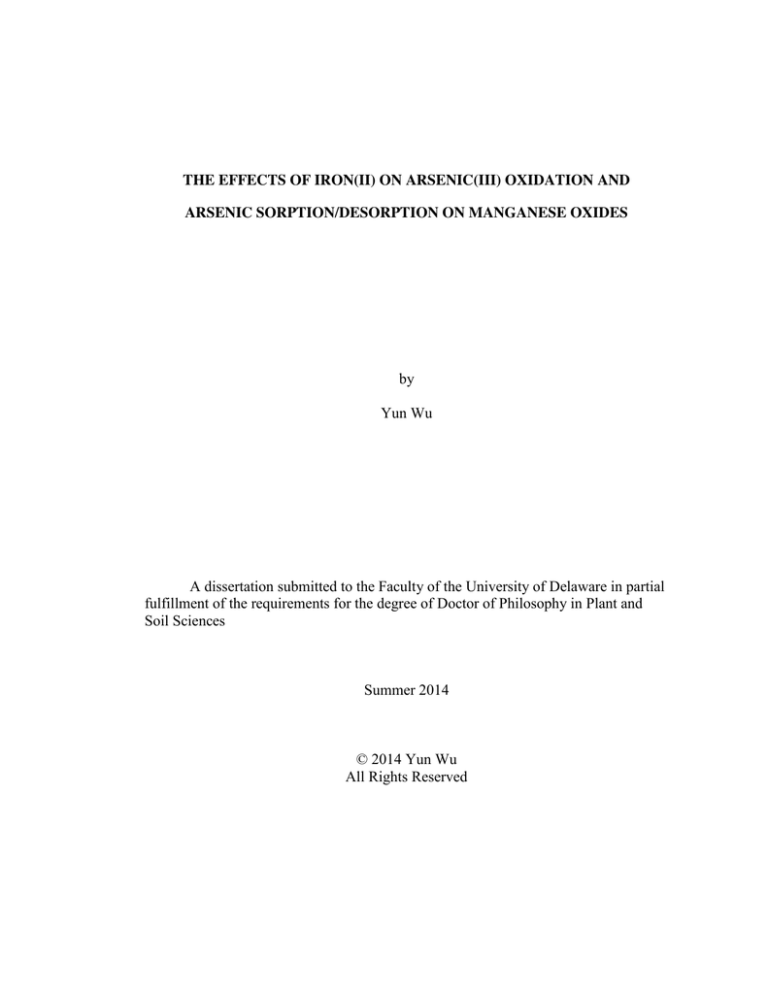
THE EFFECTS OF IRON(II) ON ARSENIC(III) OXIDATION AND
ARSENIC SORPTION/DESORPTION ON MANGANESE OXIDES
by
Yun Wu
A dissertation submitted to the Faculty of the University of Delaware in partial
fulfillment of the requirements for the degree of Doctor of Philosophy in Plant and
Soil Sciences
Summer 2014
© 2014 Yun Wu
All Rights Reserved
ABSTRACT
Arsenic contamination of groundwater and soils is a major global
environmental challenge and poses a significant health risk to millions of people
throughout the world. Both As(III) and As(V) are carcinogens, but As(III) is more
toxic and more mobile. Thus, oxidation of As(III) to As(V) is an effective way to
reduce As toxicity. As(III) oxidation by Mn-oxides has been extensively studied in the
laboratory, however, the oxidation/sorption kinetics and mechanisms of As(III) under
natural heterogeneous environments remains unclear. As(III) and Fe(II) coexist in
many As contaminated environments and the presence of Fe(II) can influence the
behavior of As(III) on Mn oxides. In this study, As(III) oxidation by a poorlycrystalline phyllomanganate (δ-MnO2) in the presence and absence of dissolved Fe(II)
was investigated using stirred-flow and batch experiments. The solids after reaction
are characterized by X-ray absorption spectroscopy (XAS), Mössbauer spectroscopy
and transmission electron microscope coupled with energy-dispersive X-ray
spectroscopy (TEM-EDS). Results showed that in the presence of Fe(II), As(III)
oxidation was inhibited due to the competitive oxidation of Fe(II) as well as the
formation of Fe(III)-(hydr)oxides on the δ-MnO2 surface. However, the sorption of
As(III), As(V) and Mn(II) increased, since the newly formed Fe(III)-(hydr)oxides
provided additional sorption sites. XAS analysis revealed that at low Fe(II)
concentration, As(V) was the predominant As species on the solid phase, while at high
Fe(II) concentration, both As(III) and As(V) were sorbed on the solid phase. As
preferred to bind with the newly formed Fe(III)-(hydr)oxides through a bidentate
xv
binuclear corner-sharing complex. Fe(III)-(hydr)oxides formed during Fe(II) oxidation
by δ-MnO2 were predominantly ferrihydrite and goethite as well as a small amount of
lepidocrocite. The adsorbed As can be desorbed from the Fe/Mn-oxides surface, to
some extent, and more As(III) is desorbed than As(V), due to the weaker binding of
As(III) with Fe/Mn-oxides. This study suggests that the oxidation of As(III) by δMnO2 in the presence of Fe(II) is very complex, involving several simultaneous
reactions. A comprehensive understanding of the As(III) oxidation and As sorption on
Mn-oxides as impacted by Fe(II) is essential and will provide significant information
that can be used to better predict the toxicity and mobility of As in the environment as
well as to develop strategies for remediation of As-contaminated waters and soils.
xvi

